Overview
The article highlights that "another name for type 2 diabetes" refers to Type 2 Diabetes Mellitus, a chronic metabolic disorder marked by insulin resistance and elevated blood sugar levels. This condition is often linked to obesity and a sedentary lifestyle, which can be overwhelming to face. It’s understandable to feel concerned about such a diagnosis.
The article provides a comprehensive overview of type 2 diabetes, detailing its symptoms and alternative terminologies. Importantly, it emphasizes the value of education and community support in managing diabetes effectively. Remember, you’re not alone in this journey; many resources and support systems are available to help you navigate these challenges.
If you or someone you know is facing this condition, seeking support and information can make a significant difference. Together, we can work towards better health and understanding.
Introduction
In a world where chronic conditions like Type 2 Diabetes are becoming increasingly prevalent, understanding its various terminologies is crucial. This article compassionately explores the multifaceted nature of Type 2 Diabetes, including its alternative names and what these terms mean for patients and healthcare providers alike. As we witness a rise in obesity and lifestyle-related health issues, it’s important to reflect on how this condition is perceived and treated. You may wonder: how do these evolving terms influence management strategies and patient education?
It's understandable to feel overwhelmed by the complexities surrounding Type 2 Diabetes. We are here to support you every step of the way, guiding you through the emotional and informational journey ahead.
Define Type 2 Diabetes: A Comprehensive Overview
Type 2 Diabetes Mellitus, which is another name for type 2 diabetes, is a chronic metabolic disorder that can feel overwhelming. It is characterized by elevated blood sugar levels due to resistance to insulin and a relative deficiency in its production. Unlike the first type, where the body struggles to produce insulin, those with Type 2 can produce it but may not use it efficiently. This condition often develops gradually and is closely linked to obesity, a sedentary lifestyle, and genetic factors.
Common symptoms include:
- Increased thirst
- Frequent urination
- Fatigue
- Blurred vision
If you’re experiencing these signs, it’s important to know you’re not alone. As of 2025, approximately 529 million individuals worldwide are affected by high blood sugar, with another name for type 2 diabetes accounting for more than 90% of these cases. In the U.S. alone, around 1.2 million new cases are diagnosed each year.
If left unmanaged, another name for type 2 diabetes can result in serious health complications, including:
- Cardiovascular disease
- Kidney failure
- Vision issues
This highlights the importance of effective management strategies. T2DSolutions is here to support you. We strive to be a comprehensive resource center for individuals impacted by Type 2 Diabetes, which is often referred to as another name for type 2 diabetes, offering education and assistance to help you manage your condition effectively.
By connecting you with vital information and community resources, T2DSolutions aims to empower you to take charge of your health. Remember, you are not alone in this journey, and we are here to support you every step of the way. Together, we can navigate this condition with confidence.
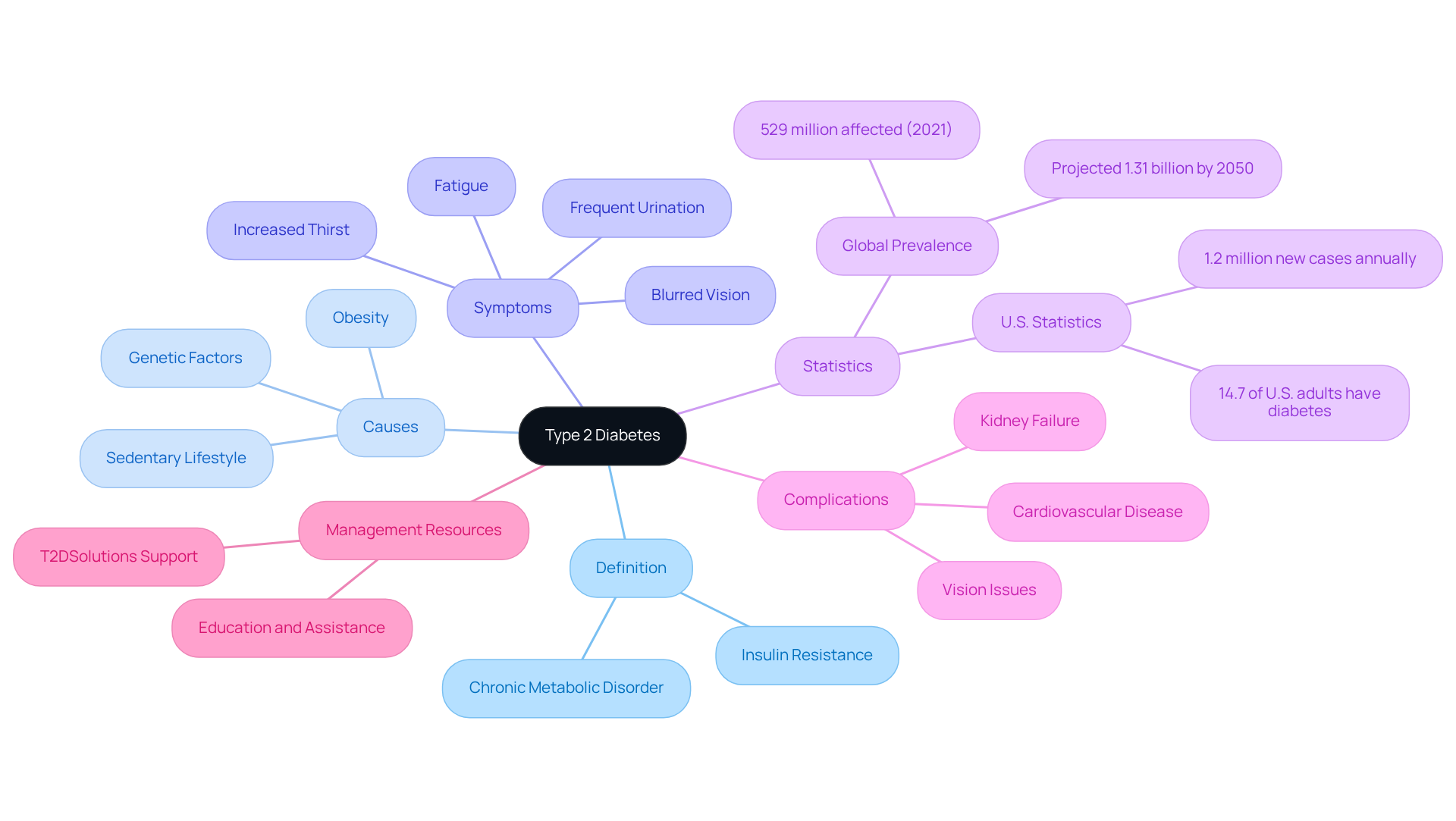
Explore Alternative Names and Terminology for Type 2 Diabetes
Type 2 Diabetes, which is another name for type 2 diabetes, is often referred to as the adult-onset condition, non-insulin-dependent mellitus (NIDDM), or simply mellitus type 2, and can feel overwhelming to understand. It's important to recognize that this condition typically develops in adults, although, sadly, we are seeing more cases in children and adolescents as obesity rates rise. The term 'non-insulin-dependent mellitus', which is another name for type 2 diabetes, is also significant; it indicates that many individuals may not require hormone treatment for management, especially in the early stages of their journey.
Understanding these terms is crucial for both patients and healthcare providers. They can influence treatment approaches and patient education strategies. Remember, you're not alone in this journey. We are here to support you every step of the way. If you have questions or need guidance, please reach out for resources or support. Your health matters, and taking the first step can lead to a brighter future.
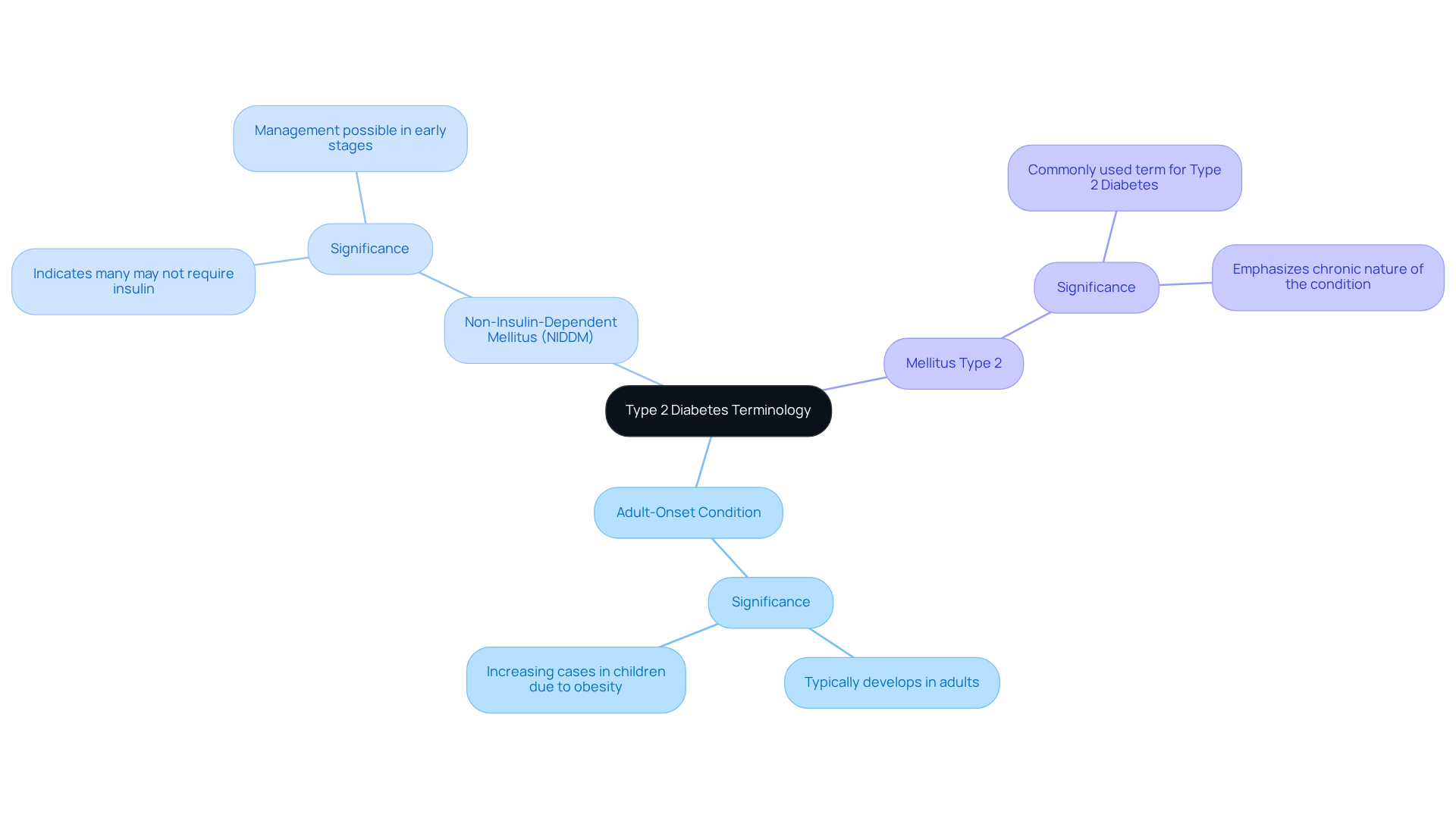
The Historical Context of Type 2 Diabetes Terminology
Historically, this form of diabetes was commonly referred to as an 'adult-onset condition,' which is another name for type 2 diabetes, due to its predominant diagnosis in adults. However, it's understandable to feel concerned about the alarming rise in obesity and lifestyle-related health issues, which has led to an increasing number of diagnoses in children and adolescents. This shift in circumstances necessitates a change in terminology. The phrase 'non-insulin-dependent blood sugar disorder' is another name for type 2 diabetes and was also prevalent, suggesting that insulin treatment was not always necessary. As research has advanced, our understanding of this condition has evolved, leading to a more refined approach to its management and the language we use to define it. This evolution reflects a broader comprehension of the disease's complexity and the necessity for personalized treatment strategies.
Significantly, statistics show that in 2021, around 41,600 new instances of youth-onset metabolic disorder were reported worldwide. This emphasizes the urgent need for revised diagnostic standards and terminology that accurately represent the current state of care for this condition. You're not alone in this journey; as T2DSolutions launches, it aims to provide newly diagnosed patients with essential educational resources and community support. We are here to help you navigate these changes in diabetes management, ensuring you feel supported every step of the way.
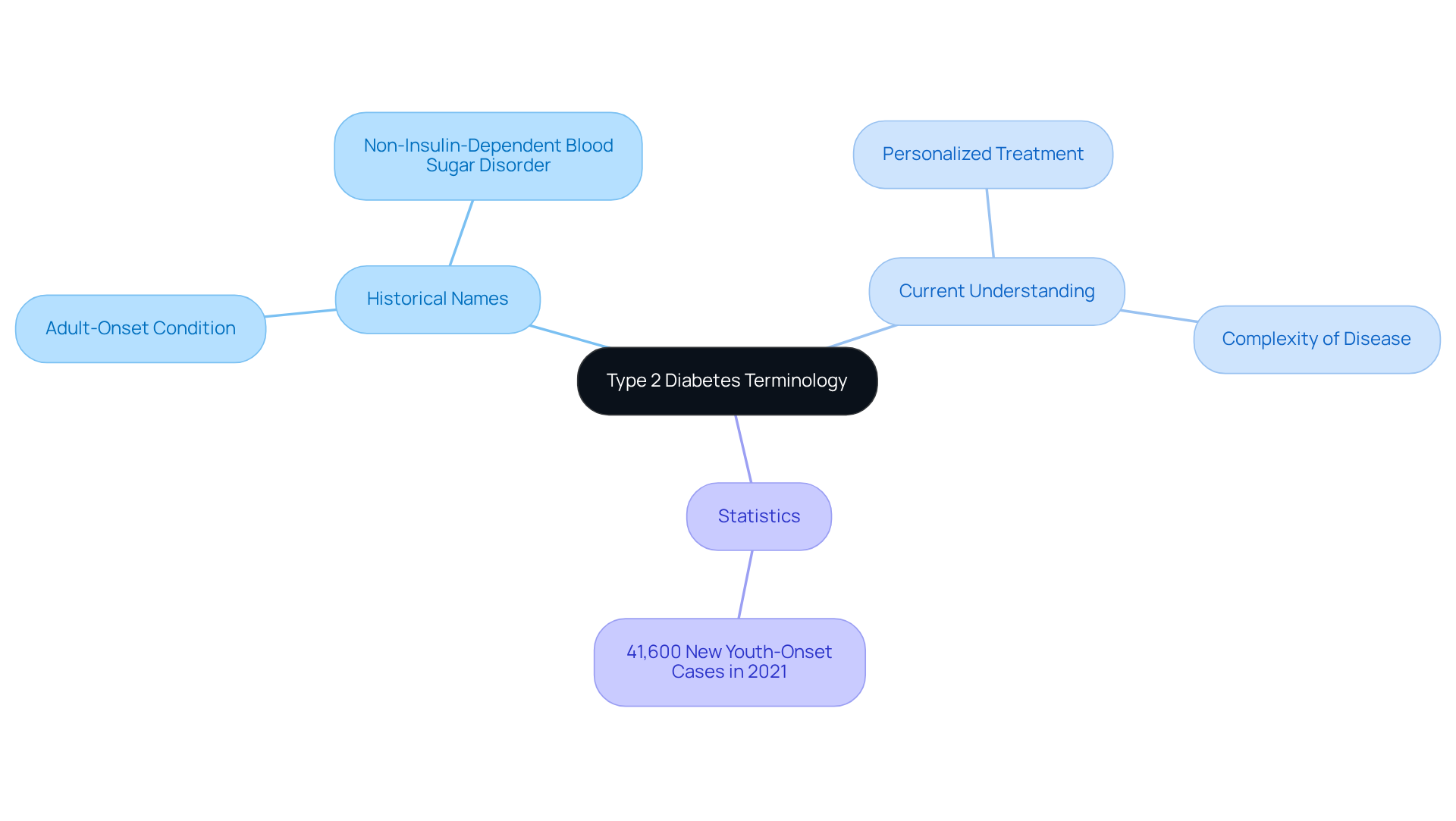
Key Characteristics and Symptoms of Type 2 Diabetes
Understanding the key characteristics of another name for type 2 diabetes can be crucial for your health. This condition often involves insulin resistance, where your body’s cells struggle to respond effectively to insulin. Additionally, there may be a relative insulin deficiency, meaning your pancreas does not produce enough insulin to keep your glucose levels stable.
Common symptoms to be aware of include:
- Increased thirst
- Frequent urination
- Fatigue
- Blurred vision
- Slow healing of wounds
You might also notice dark patches of skin, known as acanthosis nigricans, particularly in areas like your neck and armpits. Recognizing these signs is important, as early diagnosis and management can significantly reduce the risk of complications.
Remember, you're not alone in this journey. If you notice these symptoms, seeking support from healthcare providers can make a difference. Together, we can navigate this path toward better health.
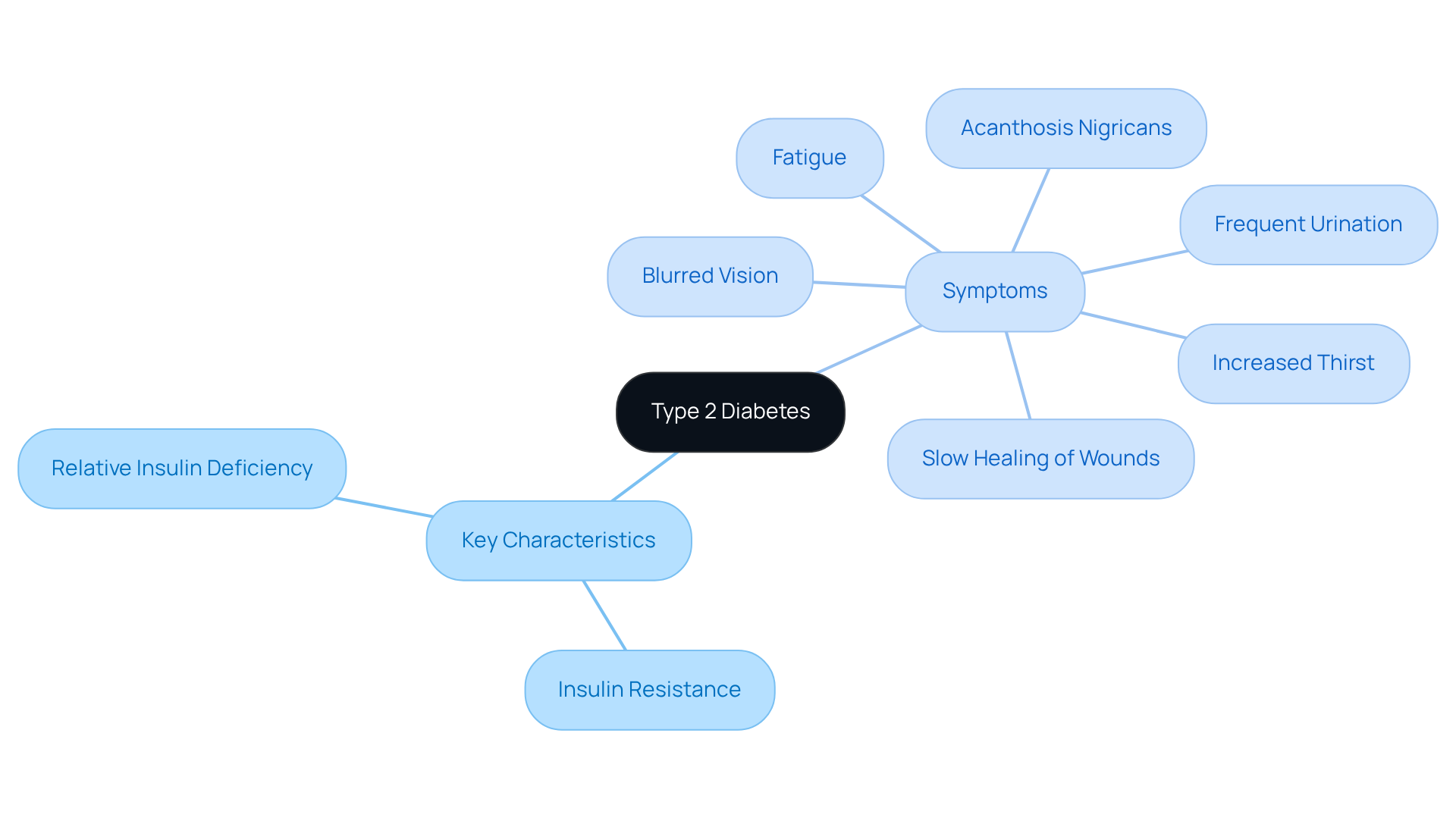
The Importance of Education and Awareness in Managing Type 2 Diabetes
Education and awareness are fundamental in managing another name for type 2 diabetes effectively. Understanding your condition, which is another name for type 2 diabetes, including its symptoms and the importance of lifestyle changes, empowers you to take control of your health. Structured education programs that cover:
- Diet
- Exercise
- Medication management
- Blood sugar monitoring
are essential for successful self-management. As we look toward 2025, recent trends in awareness campaigns emphasize the need for customized messaging that resonates with diverse communities, fostering greater engagement and participation.
Creating a supportive community where individuals can share their experiences and challenges significantly enhances motivation and resilience. It's understandable to feel overwhelmed at times, but real-world examples show how community support initiatives, such as local diabetes support groups and online forums, provide essential encouragement and resources for those navigating their diabetes journey. By prioritizing education and community engagement, you can make informed decisions that lead to improved health outcomes and a better quality of life. Remember, you're not alone in this journey; we are here to support you every step of the way.
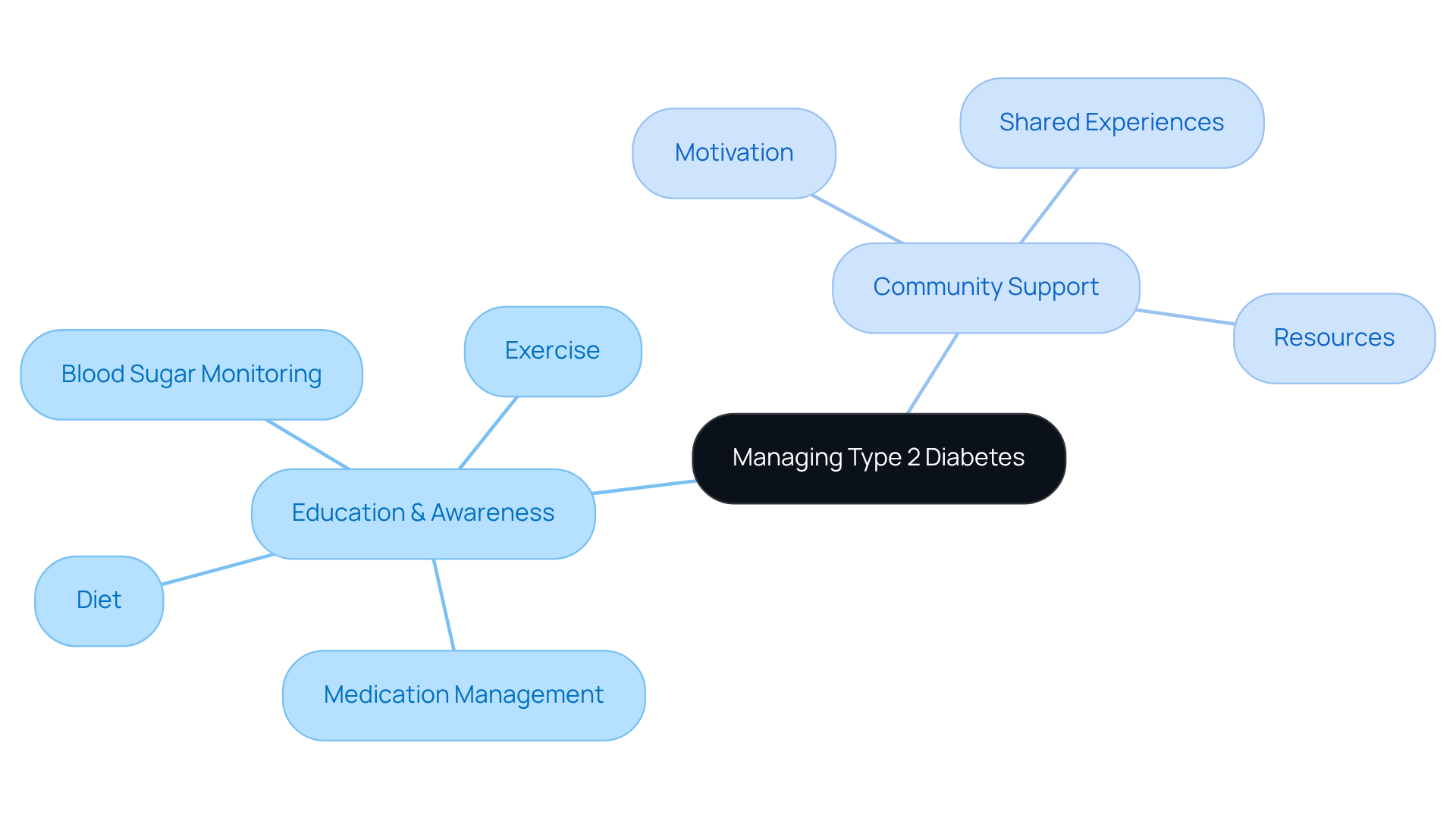
Conclusion
Understanding Type 2 Diabetes and its various terminologies is essential in navigating the complexities of this prevalent condition. It’s important to recognize that Type 2 Diabetes is not just a single term; it encompasses various names and definitions. This knowledge empowers both patients and healthcare providers, fostering effective management strategies and improving patient education, ultimately leading to better health outcomes.
Key insights discussed in the article include:
- The characteristics and symptoms of Type 2 Diabetes
- The historical context of its terminology
- The importance of education and community support in managing the condition
With over 529 million individuals affected globally, the significance of addressing this metabolic disorder cannot be overstated. By familiarizing oneself with terms like "non-insulin-dependent diabetes" and understanding the implications of these labels, individuals can take proactive steps in their health management.
It’s understandable to feel overwhelmed on this journey. However, it is vital to remember that support and resources are available. Engaging with educational programs and community initiatives can provide the necessary tools to manage this condition effectively. By prioritizing awareness and understanding, individuals can navigate their health journey with confidence and resilience. Take the first step today—your health matters, and you are not alone in this fight against Type 2 Diabetes.
Frequently Asked Questions
What is Type 2 Diabetes?
Type 2 Diabetes Mellitus is a chronic metabolic disorder characterized by elevated blood sugar levels due to insulin resistance and a relative deficiency in insulin production. Unlike Type 1 Diabetes, individuals with Type 2 can produce insulin but may not use it efficiently.
What are the common symptoms of Type 2 Diabetes?
Common symptoms include increased thirst, frequent urination, fatigue, and blurred vision.
How prevalent is Type 2 Diabetes worldwide?
As of 2025, approximately 529 million individuals worldwide are affected by high blood sugar, with Type 2 Diabetes accounting for more than 90% of these cases. In the U.S. alone, around 1.2 million new cases are diagnosed each year.
What complications can arise from unmanaged Type 2 Diabetes?
If left unmanaged, Type 2 Diabetes can result in serious health complications such as cardiovascular disease, kidney failure, and vision issues.
What are some alternative names for Type 2 Diabetes?
Type 2 Diabetes is also referred to as adult-onset diabetes, non-insulin-dependent diabetes mellitus (NIDDM), or simply mellitus type 2.
Who is primarily affected by Type 2 Diabetes?
Type 2 Diabetes typically develops in adults, but there is a growing number of cases in children and adolescents due to rising obesity rates.
What does the term "non-insulin-dependent" indicate?
The term "non-insulin-dependent" indicates that many individuals with Type 2 Diabetes may not require insulin treatment for management, especially in the early stages of the condition.
How can T2DSolutions help individuals with Type 2 Diabetes?
T2DSolutions aims to be a comprehensive resource center for individuals impacted by Type 2 Diabetes, offering education, assistance, and community resources to help manage the condition effectively.



